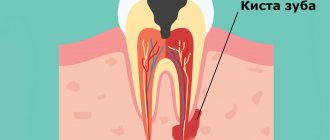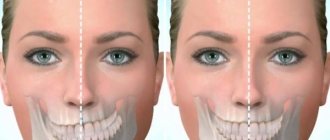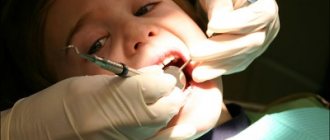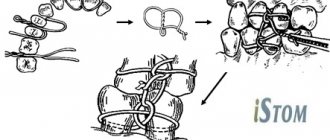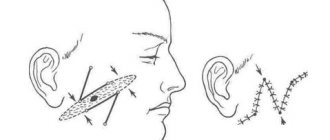Types of osteomas
Diagnosis of osteoma involves differentiation from similar neoplasms and determination of its type in order to select subsequent treatment.
Tumors are divided by number, type of tissue they are made of, method of germination and complexity of structure. Each of them can be located in different parts of the musculoskeletal system and provoke different symptoms. Based on the number of tumors, they are divided into single (solitary) and multiple, and based on their composition into solid, spongy and medullary. The first consist entirely of bone tissue without bone marrow, the second of spongy substance, and the third of bone marrow cavities. Tumors originate from different tissues (bone or connective) and because of this they have different names:
- hyperplastic – consist exclusively of bone (osteomas and osteoid osteomas),
- heteroplastic - osteophytes, composed of different tissues.
Osteomas are composed of normal bone tissue, are localized on the bones of the skull, and often put pressure on neighboring organs, such as the eyes. Osteoid osteomas consist of osteogenic tissue penetrated by blood vessels, bone membranes, areas of destroyed bone tissue, and are localized anywhere, in 50% of cases - on the tibia. At the initial stage of development of the disease, there are no symptoms, and then a flat, thin infiltrate appears (if we talk about epiphyseal osteoma, it accumulates in the joint). If in children this type of tumor occurs in the bone growth zone, then one limb will increase in length.
Osteophytes are also divided into 2 types - ectostoses, which grow from above (the skull, face, pelvic bones are the favorite places for their localization), and enostoses, internal, growing into the medullary canal. Exostoses have the shape of a hemisphere, cauliflower, thorn, or mushroom. One of the features of osteophytes (heteroplastic osteomas) is that they appear on the diaphragm, lining of the heart, brain tissue, etc.
General information
Among tumors/tumor-like lesions of the skeleton, benign bone tumors account for about 50% of cases, of which the most common are bone-forming benign tumors: osteoma and osteoid-osteoma , which are independent nosological units. These types of tumors are characterized by slow, non-aggressive growth and a favorable course: they do not grow into surrounding tissues, do not metastasize, and do not become malignant. ICD-10 code: D16 - Benign neoplasms of bones and articular cartilage.
Osteomas
What is osteoma? It is a benign osteogenic tumor of mature/differentiated bone tissue. They occur predominantly in people 20-35 years old, with the exception of osteomas of the facial bones, which are more common in women. A specific feature of osteomas is the identity of its structure with normal bone tissue. The localization of osteomas varies significantly and is determined by its type. Thus, spongy osteoma is localized mainly on the long tubular bones of the extremities, most often on the humerus/femur. Compact osteoma affects predominantly flat bones of the vault/base of the skull (osteoma of the orbital region, osteoma of the occipital bone and frontal bone, osteoma of the frontal sinus and other maxillary sinuses of the nose, mandible), as well as other flat bones (osteoma of the scapula and ribs). Osteoma, as a rule, is a single tumor and a multiple variant of development ( Gardner–Turner syndrome ) is much less common. Osteoma is much less common in long and short bones.
The most common location of osteomas is on the bones of the skull
Osteoma is determined mainly in the form of a painless, single smooth/lumpy protrusion with clear boundaries and a dense consistency. The tissue of osteoma macroscopically represents dense or spongy bone, and macroscopically the tissue of compact osteoma is similar to the structure of the cortical layer of bone, however, it differs from it in the general plan of the structure: the Haversian canals (osteon canals) are arranged randomly and have a nonspecific shape. The tissue of cancellous osteoma is presented in the form of an interlace of convoluted bone beams of different maturity, which are enclosed in cellular fibrous tissue.
Osteoid osteoma
Osteoid osteoma is a benign tumor of bone tissue that includes a central avascular node (nidus), a fibrovascular ring and a reactive rim of dense bone surrounding it. As a rule, osteoid osteomas are a single (solitary) neoplasm with clear contours, the size of which does not exceed 1 cm in diameter, and is localized in any bone of the skeleton with the exception of the sternum, clavicle, phalanges of the fingers and skull bones. It can be located in both cortical and cancellous bone.
Macroscopically, osteoid osteomas have an ovoid/spherical shape with a loose formation in the central sections with increasing tumor density towards the periphery; on a section they are gray-red in color. It accounts for 9-12% of all benign bone tumors. It is more often detected in men aged 5-25 years. (80% of cases), and in persons after 40 years of age they are practically not observed. In terms of frequency of lesions, it occupies the proximal femur, followed by the tibia and, somewhat less frequently, the humerus and vertebrae.
Causes
The cause of osteoma is said to be heredity, but its appearance and progression can also be facilitated by certain diseases, including gout, syphilis and rheumatism (the trigger is often trauma, especially repeated trauma). The pathology of calcium metabolism sometimes causes the development of inert tumors, the pathological development of embryonic cells can lead to the development of growths, and when localized in the nasal sinuses - a purulent complication or inflammation, puncture of the maxillary sinus. Ectostoses can form during puberty.
Symptoms
The signs of osteomas depend on the location, are not similar to each other, and are sometimes difficult to differentiate due to symptoms similar to other common diseases. It is easier to make a diagnosis in the presence of convex external tumors that are visible to the naked eye.
If the tumor is located on the bones of the head, depending on the location, symptoms are observed:
- on the posterior wall of the frontal sinus - intracranial pressure, headaches (do not go away), size from 2 to 30 mm;
- on the lower wall of the frontal sinus - moving the eye forward;
- on the frontal bone (internal plates) - memory problems, headaches, seizures with convulsions, intracranial pressure;
- in the nasal cavity - difficulty breathing through the nose, decreased sense of smell, problems with the eyes (drooping eyelid, double vision, decreased vision);
- on the occipital bone - pain in the head, sometimes epileptic seizures;
- on the parietal and temporal bone - noticeable, but does not cause painful symptoms;
- on the lower jaw (lateral branch or posterior side) - when compressing the soft tissues of the muscles, they can lead to asymmetry and dysfunction, the edges of the tumor are smooth, and the shape is oval or round.
In addition to the bones of the skull, the tumor also affects the bones of other parts of the musculoskeletal system, respectively, symptoms of osteoma and pain appear at its location:
- thigh bones - muscle pain, worse at night, swelling in the legs, altered gait;
- knee joint - makes movement difficult;
- vertebral arch or its process – the formation of scoliosis, symptoms of spinal compression, pain.
Pain due to osteophytes is eliminated completely or partially with the help of analgesics, however, if there are regular repeated attacks of pain, difficulty moving, or the appearance of visible lumps, you should immediately consult a doctor to avoid complications.
Rehabilitation and prognosis
The recovery period after surgical intervention in the lower/upper jaw - excision of osteoma - is usually favorable. If the lesion is small, no dental correction is required, since the bite is not disturbed. It is enough for a person to eat right and lead a healthy lifestyle. The prognosis is favorable.
If the osteoma has reached a large size and the intervention area is significant, the dentist will subsequently recommend dental implantation so that you can chew food. Rehabilitation periods are lengthened. Nevertheless, the prognosis remains favorable - such tumors rarely degenerate into cancer. It is enough to follow all the doctor’s recommendations, give up bad habits and undergo regular jaw checkups.
Diagnostics
Diagnosis of the tumor is carried out to determine its type and location in order to select tactics for treating osteoma. As part of its implementation, X-ray and CT are used. The most informative is a 3D reconstruction; it shows all the details and outlines, as well as the extent of damage to surrounding tissues. In the process, it is important to differentiate osteoma from chronic Brody’s abscess, organized periosteal callus, osteochondrosis dissecans, osteogenic sarcoma, osteoperiostitis and other diseases.
Before prescribing an x-ray or tomography, the doctor conducts an examination and identifies:
- presence of pain when pressing;
- location;
- growth rate;
- functionality of the tissue that has been affected.
Using X-rays, a specialist detects the number of tumors, their structure, location, and the degree of bone destruction. It should be noted that on an x-ray the exostosis looks smaller than in reality, since its upper cartilaginous layer is not visible. In children it reaches a thickness of several centimeters. The benign nature of the tumor is indicated by correct geometry and structure, a clear contour, a small degree of calcification and growth at a low rate.
The essence of the diagnosis
Osteoma is a benign tumor. It grows slowly, sometimes spasmodically, almost asymptomatically. Often it can be accidentally discovered on an x-ray when other diseases of the teeth and gums (for example, periodontitis) are suspected. Its basis is compact bone tissue or spongy bone tissue (sometimes both types).
The latter type of bone is less commonly affected. Such a neoplasm does not appear after dental disease (non-ondogenic nature of the tumor). The formation of its cells is comparable to the formation of normal bone cells. Its localization is the maxillofacial part of the skeleton (most often the lower jaw bones).
In other places, the tumor forms very rarely. Particular activity of osteoma of the jaw occurs during adolescence and young adulthood, a period of active growth.
A large osteoma of the lower jaw presses on the nerve of the lower jaw. Because of this, signs of diseases of a neurological nature arise. A large tumor interferes with the good opening and closing of the lower jaw, and can even completely immobilize it.
A large osteoma of the upper jaw can sometimes grow into the bones of the orbit (immobilization of the eye), the maxillary sinuses (impaired breathing through the nose). When a large tumor appears on the upper palate or on the alveolar process, problems arise with the installation of dentures. If the tumor is very large, then it disrupts the symmetry of the face.
Osteoma is a holistic neoplasm that is immobile, dense, and does not change the color of the mucous membrane that covers the tumor on top. It is isolated from the tissues that are nearby and does not grow together with them. Osteoma is not characterized by various abscesses: suppuration does not form on top of it.
Treatment
Removal of osteoma is indicated if it compresses neighboring organs, is visible visually, that is, acts as a cosmetic defect (especially on the face and head), changes the shape of bones, reduces mobility, leads to scoliosis, and causes pain. Most often, tumors are removed from the sinuses, ear canal, jaws, knee and hip joints.
If the tumor does not manifest itself in any way and does not cause discomfort, the doctor observes it and evaluates its growth rate. A small osteoma that has stopped growing does not need to be removed or treated.
The operation to remove the tumor is performed by maxillofacial surgeons or neurosurgeons. During the operation, the doctor cuts the tissue, removes the growth and part of the bone/tissue around it to avoid relapse.
The doctor will suggest removing the osteoma in the following ways:
- complete excision – used for tumors in the sphenoid sinus;
- curettage - an incision in the skin, removal of a tumor, cleansing the lesion by curettage;
- endoscopic removal - suitable for small tumors with a difficult approach, used using computed tomography to monitor the progress of the operation and a radiofrequency probe, takes about 2 hours.
Tumor recurrence occurs in 10% of cases due to incomplete removal. To exclude this possibility, you need to choose a good clinic and specialist.
CHAPTER XXIV OSTEOGENIC BENIGN TUMORS OF THE JAWS
OSTEOMAS OF THE JAWS
General information
Osteoma (from os - bone) is a relatively rare tumor of the jaws, built from relatively mature bone tissue; located in the spongy or cortical substance of the jaw. Osteoma is most often localized on the lower jaw, but can be on the inner wall of the maxillary sinus, in the nasal cavity, and also in the thickness of the parotid gland. According to our clinic, it is found in 2.73% of patients admitted for inpatient treatment for benign tumors. According to A. A. Kolosov (1964), osteoma accounts for 6% of all primary tumors and tumor-like formations of the jaws.
Clinic
Osteomas grow very slowly, without making themselves felt for many years. The first complaints of patients depend on the location and volume of the tumor: having developed in the thickness of the lower jaw,
it eventually causes neuralgic pain in the inferior alveolar nerve and asymmetry of the lower half of the face;
localized on the coronoid
process, it causes a gradually increasing restriction of movements of the lower jaw, and growing into
the nasal cavity, it makes breathing through the corresponding half of the nose difficult
The last thing to manifest itself is osteoma, which has grown into the maxillary sinus and gradually fills
her; in this case, the osteoma takes the form of a cavity and is discovered either by chance during an X-ray examination of the paranasal sinuses or upper jaw for another reason, or as a result of a gradual increase in facial asymmetry, or the development of contracture of the lower jaw. Contracture is associated with deformation and displacement of the tubercle of the upper jaw by the tumor outward.
The size of the osteoma depends on the year of tumor growth when the examination is performed:
with a long period of growth, the size of the tumor can be significant.
Small osteomas usually do not cause any functional or cosmetic impairment; they develop painlessly. However, having reached large sizes, they can not only deform the face and cause restrictions
tion of opening the mouth, but also to displace the eyeball.
Histologically, osteomas are divided into compact, spongy and soft. First
differ from normal compact bone by a violation of the architectonics and narrow vascular canals (osteoma ebumeum, seu compactum).
Osteon channels are almost completely absent in them. Spongy
(or spongy) osteoma (osteoma spongiosum) has a spongy, porous substance.
Unlike normal cancellous bone, the beams in spongy osteoma are located randomly, not in accordance with the functional structure; their degree of maturity varies - from lamellar to primitive fine-fibrous. On an x-ray, it resembles a focus of osteodystrophy or adamantinoma. Its peripheral parts look denser, that is, contrasting. Soft osteomas
consist of bone substance characterized by the presence of large medullary cavities.
Diagnosis and differential diagnosis
Diagnostics of compact
Osteoma is not difficult: a clear radiographic sign of “plus tissue” indicates the presence of a dense osteoma, standing out against the background of more radiolucent bone.
Spongy and soft
osteomas must be distinguished from osteoblastoclastomas, solid adamantines, bone dysplasias (see below), as well as osteophytes, exostoses, and chronic periostitis.
Particular difficulties may arise during differentiation:; osteoma with osteoplasia.
The latter are distinguished by the immaturity of bone tissue, revealed by histological examination. When examining pieces of bone taken from the surface of the lesion, one can detect areas of mature bone with the phenomena of resorption and the formation of peculiar trabecular structures. It is these structures that are sometimes mistakenly regarded as cancellous osteoma.
Bone spines -
osteophytes or larger protrusions - exostoses often arise as a result of traumatic irritation or chronic inflammation of the jaw periosteum, which can be identified in patients when taking an anamnesis.
Treatment
Treatment of osteomas is only surgical - radical removal of the tumor, performed in the case of functional or cosmetic disorders, as well as if there are indications for surgery in connection with the upcoming removable denture.
Part V. Benign neoplasms of the maxillofacial area
On the inside
On the surface of the lower jaw there are sometimes congenital,
symmetrically
located exostoses that cannot be diagnosed as osteomas. The same applies to the torus palatinus. However, in the interests of creating optimal conditions for the manufacture and use of removable dentures, it is sometimes necessary to resort to surgical removal of osteogenic growths (chipping, milling) of these protrusions.
The prognosis is favorable.
OSTEOID OSTEOMAS
General information
Osteoidosteoma, or soft osteoma (osteoidosteoma, seu osteoma molle), some authors refer not to true tumors, but to a manifestation of reactive inflammation. It is found in the jaws extremely rarely (according to A. A. Kolesov - in 0.5% of patients with tumors and tumor-like formations of the jaws).
Soft osteoma is localized in the spongy or cortical bone, or subperiosteally. The tumor size is small - from 5 to 20 mm in diameter
Clinic
It manifests itself as aching, periodically worsening pain, especially at night. The analgesic effect of aspirin is considered characteristic. Localized superficially, it causes facial asymmetry.
Diagnosis
The radiograph reveals a delineated zone of clearing along the periphery and increased radiopermeability of the tumor in its central part. This sometimes resembles the picture of a rounded odontoma. However, another option may be noted - a continuous, non-delineated increased x-ray permeability of the entire tumor
Histologically, soft osteoma is characterized by the presence of osteogenic connective tissue with non-calcified or weakly calcified beams. A fibrous capsule or zone of sclerosis often develops around this tumor focus.
It is almost impossible to make a diagnosis without preliminary pathohistological examination.
Treatment is thorough curettage.
Prognosis: relapses are possible.
OSTEOBLASTOCLASTOMA
General information
Among primary tumors of the jaw bones, osteoblastoclastomas account for 65%, of which: centrally located - 17%, and peripheral (the so-called giant cell epulids) - 48% (A. A. Kolosov, 1964).
According to our clinic, osteoblastoclastomas occupy first place among non-odontogenic benign tumors of the jaw, accounting for 20.7% (± 1.84%). This neoplasm has many different names, for example, gigantoma, giant cell tumor, brown tumor, intraosseous epulid (according to I.G. Lukomsky), local fibrous osteodystrophy (according to Stenholm), osteoblastoclastoma (according to A. V. Rusakov)
The microscopic structure of osteoblastoclastoma is characterized by the presence of two main types of tumor cells: a) multinucleated giant cells involved in resorption
bone beams (osteoclasts), and b) mononuclear giant cells, which are cells of the osteoblastic series, that is, taking part in the
construction
of new bone beams; this process of reconstruction can often be observed in the peripheral part of the tumor. Mononuclear cells are called osteoblasts. Thus, there is no fundamental difference between the main histological elements of giant cell epulide and osteoblastoclastoma.
The difference between them consists only in the following topographic and histological features:
1. Giant cell epulide
is localized on the gum and is therefore called the peripheral form of osteoblastoclastoma, while the tumor located in the thickness of the jaw is its central form.
2. Central form
Osteoblastoclastoma, in contrast to peripheral one, has a mottled or brown appearance on the section due to the presence of many hemorrhagic foci penetrating it and disintegrated hemosiderin, cavities in the form of blood or serous cysts.
Sometimes this tumor is surrounded by a fibrous membrane, and blood vessels are found only in the peripheral parts of the tumor. In its depths, the blood elements are located directly among the tissue elements. This phenomenon is incorrectly regarded as hemorrhage. Blood circulates among the tumor elements very slowly; in some places, sedimentation of erythrocytes, plasma sedimentation, and a kind of “swamping” of the bone occurs. The settled red blood cells undergo decay, their hemoglobin is converted into hemosiderin, which gives the central osteoblastoclastoma a characteristic brown
tint; this also served as the basis for calling it “brown tumor” (brauner tumor).
Blood or serous bone cavities are created in areas of stagnation of blood, and sometimes the entire tumor turns into a single cystic cavity (cystic form of osteoblastoclastoma), thereby reminiscent of the advanced form of cystic adamantinoma of the jaw. If the contents of the cyst have undergone organization, this leads to the formation of fibrous areas in it.
The described histological structure is characteristic of the vast majority of central osteoblasts.
Yu I Vernadsky Fundamentals of maxillofacial surgery and surgical dentistry
Fig. 90 Peripheral form of osteoblastoclastoma of the upper jaw
stoclastoma However, there may also be so-called spindle cell chondroma tosus variants
of this tumor. In
the first
variant, spindle-shaped mononuclear elements predominate (which makes it similar to spindle cell
sarcoma),
and in
the second
, the presence of not only areas such as osteoblastoclastoma is noted, but also more or less extensive growths of homogeneous cells such as chondroblasts, among which the formation of the main substance occurs , characteristic of cartilage tissue.
Osteoblastoclastomas mainly affect females aged 11 to 20 years. They are localized on the lower jaw almost twice as often as on the upper jaw, and their favorite place of growth is the area of the lower large molars, and in the upper jaw - small molars
Clinic
Patient complaints vary depending on the location and stage of tumor development
(usually for the presence of facial asymmetry due to a slowly growing tumor, only occasionally painful). Sometimes patients also complain about a periodically occurring inflammatory process in the tumor area, ending with the appearance of a purulent fistula on the gum or face. In this case, patients sometimes note the appearance of a symptom of instability and mobility of the teeth located in the tumor area.
The appearance of inflammatory layers with fistulas
(see Fig. 91 a) is one of the distinctive features of osteoblastoclastomas of the jaws (in
tubular
bones, gigantomas
are not complicated by inflammation
The appearance of inflammation and fistulas is associated with the presence of a carious tooth and infection of the oral cavity. Infection of the tumor occurs either marginally through the periodontium, or through a wound after tooth extraction or spontaneous loss. If the tumor is localized near the temporomandibular joint, the patient may complain of pain when moving the jaw , especially during chewing
Is osteoma dangerous?
Speaking about the dangers of osteoma, one should note first of all the compression of neighboring organs and symptoms that cause inconvenience to the patient. If the tumor does not manifest itself and does not grow, it can be left in place. A neoplasm of this kind never develops into malignant – there is no need to be afraid of cancer. Tumors on the head should be treated with particular care - they not only cause unpleasant symptoms, but can also lead to a brain abscess. As a rule, they are removed surgically.




